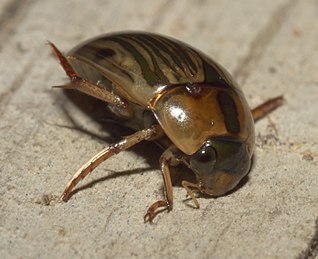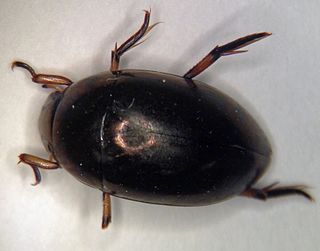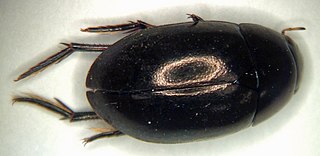
Elaphropus is a genus of ground beetles in the family Carabidae. There are at least 370 described species in Elaphropus.

Margarinotus is a genus of clown beetles in the family Histeridae. There are at least 110 described species in Margarinotus.

Tropisternus collaris, the collared water scavenger beetle, is a species of water scavenger beetle in the family Hydrophilidae. It is found in the Caribbean, North America, and South America.
Stereopalpus is a genus of antlike flower beetles in the family Anthicidae. There are about 11 described species in Stereopalpus.
Tropisternus glaber is a species of water scavenger beetle in the family Hydrophilidae. It is found in North America.

Tropisternus blatchleyi is a species of water scavenger beetle in the family Hydrophilidae. It is found in North America.

Laccobius cinereus is a species of water scavenger beetle in the family Hydrophilidae. It is found in Europe & Northern Asia and North America.
Hydroporus columbianus is a species of predaceous diving beetle in the family Dytiscidae. It is found in North America.
Tropisternus quadristriatus is a species of water scavenger beetle in the family Hydrophilidae. It is found in the Caribbean and North America.
Laccobius borealis is a species of water scavenger beetle in the family Hydrophilidae. It is found in Central America and North America.

Tropisternus natator is a species of water scavenger beetle in the family Hydrophilidae. It is found in North America.
Cercyon limbatus is a species of water scavenger beetle in the family Hydrophilidae. It is found in North America.
Tropisternus mixtus is a species of water scavenger beetle in the family Hydrophilidae. It is found in North America.
Phaenonotum exstriatum is a species of water scavenger beetle in the family Hydrophilidae. It is found in the Caribbean, Central America, and North America.
Ametor latus is a species of water scavenger beetle in the family Hydrophilidae. It is found in North America.
Paromalus teres is a species of clown beetle in the family Histeridae. It is found in North America.
Paracymus nanus is a species of water scavenger beetle in the family Hydrophilidae. It is found in the Caribbean and North America.
Hypocaccus fraternus is a species of clown beetle in the family Histeridae. It is found in North America.
Hydrochus rufipes is a species of water scavenger beetle in the family Hydrochidae, sometimes treated as a member of the family Hydrophilidae. It is found in North America.
Cercyon floridanus is a species of water scavenger beetle in the family Hydrophilidae. It is found in North America.








